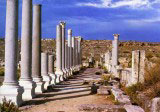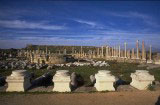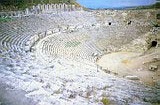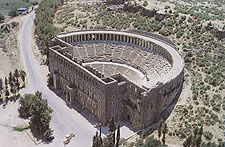- Welcome Cocktail
- Monday May 21, 19.00-21.00
 Visit to the Antalya Museum
Visit to the Antalya Museum
- Tuesday May 22, 17.30-19.30
- Sunset on the beach
- Tuesday May 22, 19.30-22.30
- Banquet Dinner
- Wednesday May 23, 20.00-23.00
- Excursion to Perge - Aspendos, fish dinner at Duden
- Thursday May 24, 14.00-22.00
Perge



An important city of ancient Pamphylia, Perge was originally settled by the Hittites around 1500 BC. St. Paul preached some of his first sermons here. One can see the ruins of the antique theatre (capacity 12,000 people), its stage has marble reliefs about the life of Dionysos, a stadium for 12,000 people; remains of the first church built in Perge, an agora, which has dimensions of 76x76m and it's surrounded by Corinthian colums, in the middle of it there is a round temple of Tyche (2nd century A.D.); a basilica - another structure from Christian Era with three entrances; a Roman Bath, and Hellenistic gates. Perge is also the birth-place of Apollonius, the mathematician who is author of a famous treatise on geometry.Aspendos
 Aspendos Theatre is the best-preserved theater of
antiquity, with seating for 15,000. Still used
today, the theater's galleries, stage decorations
and acoustics all testify to the architect's
success. Nearby stand the remains of a basilica, agora
and one of the largest aqueducts in Anatolia.
Aspendos Theatre is the best-preserved theater of
antiquity, with seating for 15,000. Still used
today, the theater's galleries, stage decorations
and acoustics all testify to the architect's
success. Nearby stand the remains of a basilica, agora
and one of the largest aqueducts in Anatolia.
It is believed that Aspendos was founded by colonists from Argos. In the 6th century B.C. the Lydians reigned here until they were defeated by the Persians. In 333 B.C. Alexander the Great came to Pamphylia and invaded the city. In 190 B.C. Aspendos was Pergamonian. Then it fell into the hands of the Romans. Most of the huge buildings of the city date back from that period.
The architect Zenon built the well-preserved theatre in the 2nd century A.D. during the reign of Emperor Marcus Aurelius, from Aspendos. The auditorium has a semicircular form and a diameter of 95 metres (285 feet). The well-preserved scena building is 30 metres (90 feet) high.